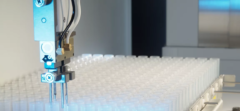Cancer care: Digital solutions for early detection of hepatocellular carcinoma
Each year in Germany, approximately 500,000 people are diagnosed with cancer.1 For affected patients, early detection is essential to increase their chances for survival.2 Hepatocellular carcinoma (HCC) in particular is one of the leading causes of cancer-related death globally. However, if identified at an early state, surgical resection offers a favorable prognosis, with 5-year survival rates of more than 70%.3
Clinical algorithms are increasingly important in the race to identify high-risk patients — especially at the early and potentially curative stage of disease. Beginning in December 2022, Prof. Dr. R. Lichtinghagen, laboratory director at University Hospital in Hannover – Medizinische Hochschule Hannover – committed to utilizing the CE certified algorithm GAAD hosted by navify Algorithm Suite digital solution to capture the clinical benefits of the GAAD solution for hepatocellular carcinoma (HCC).
According to Prof. Dr. Lichtinghagen, results of the study bode well for enabling local digital transformation in HCC patient management on a larger scale, with a continually expanding certified algorithm library.











